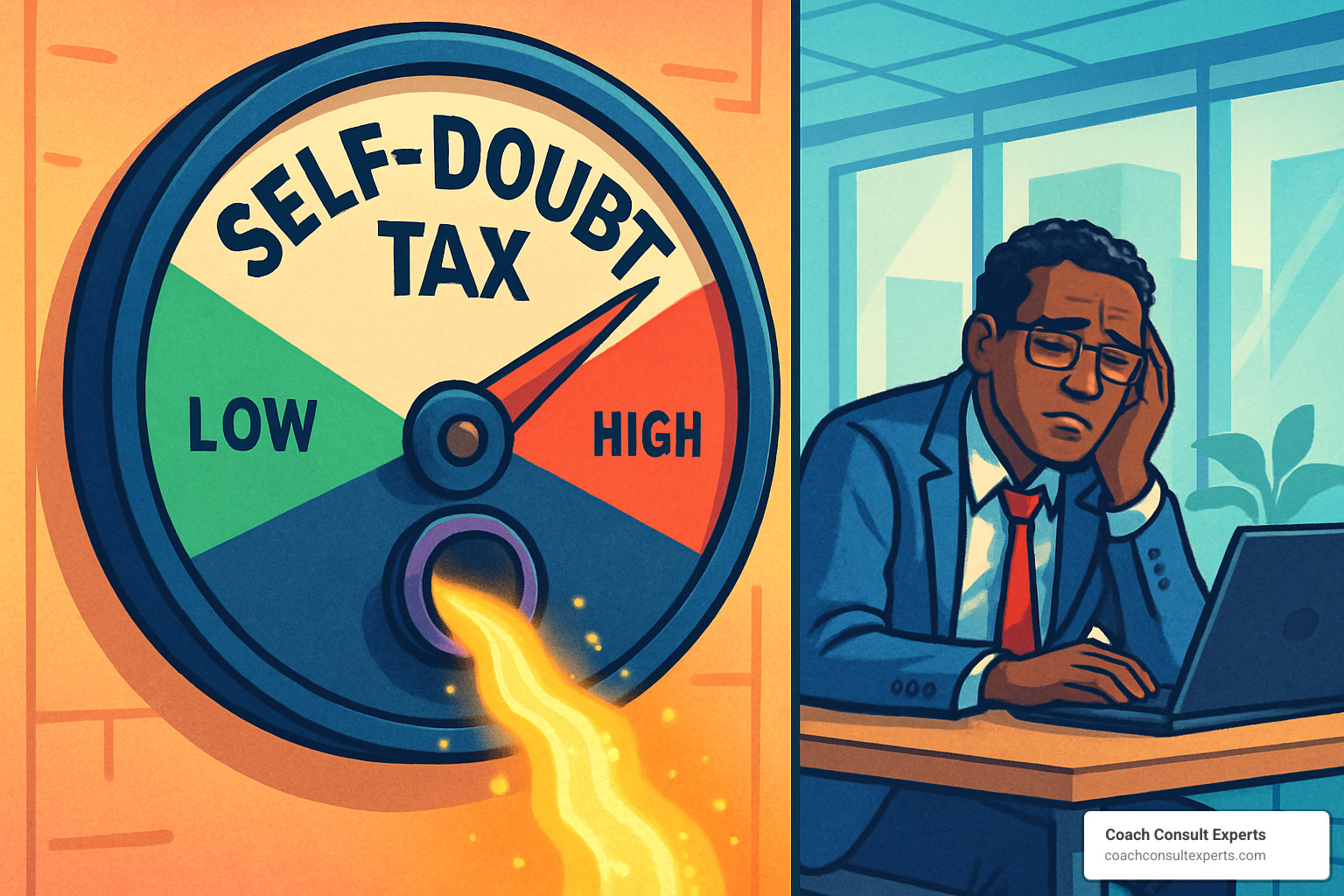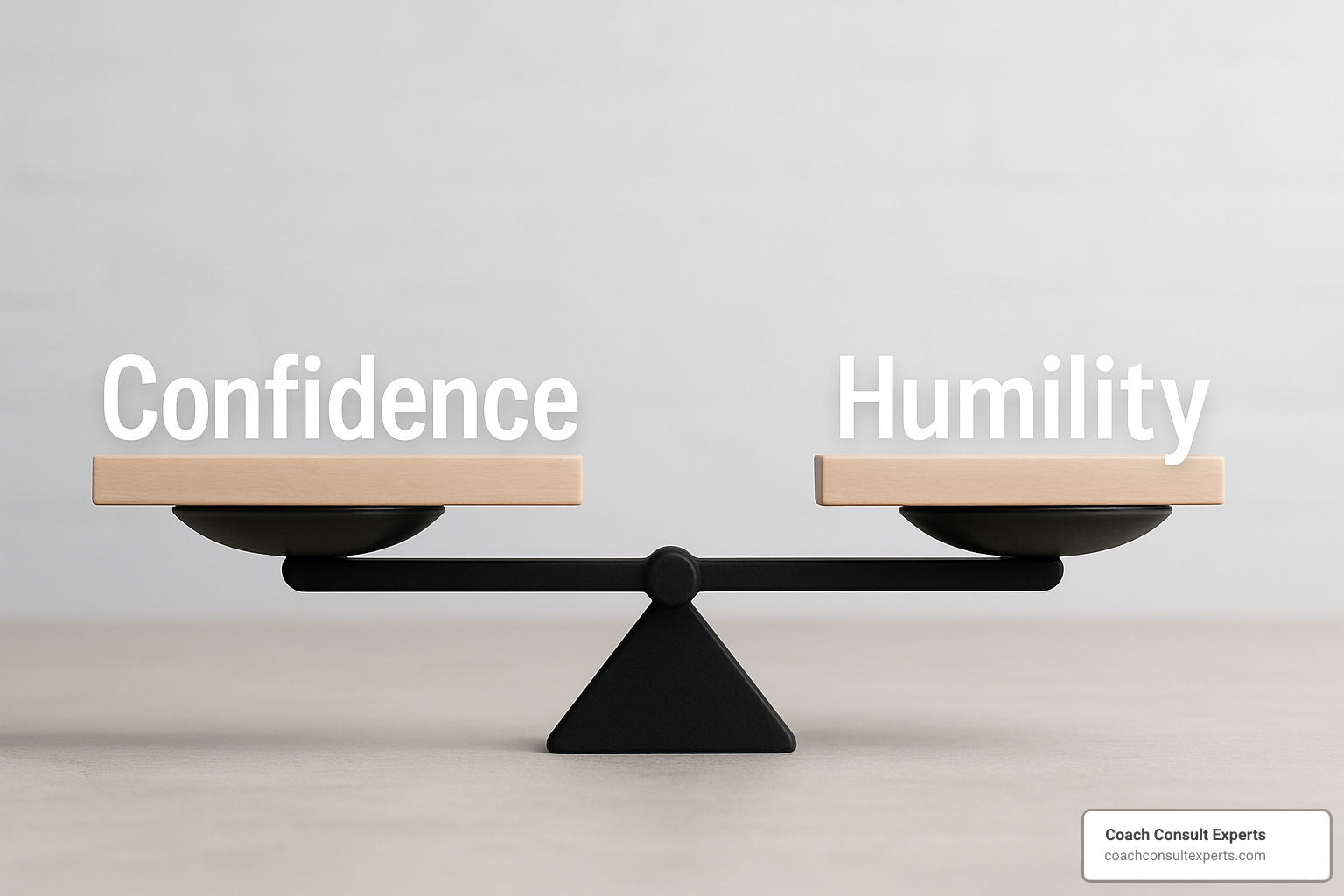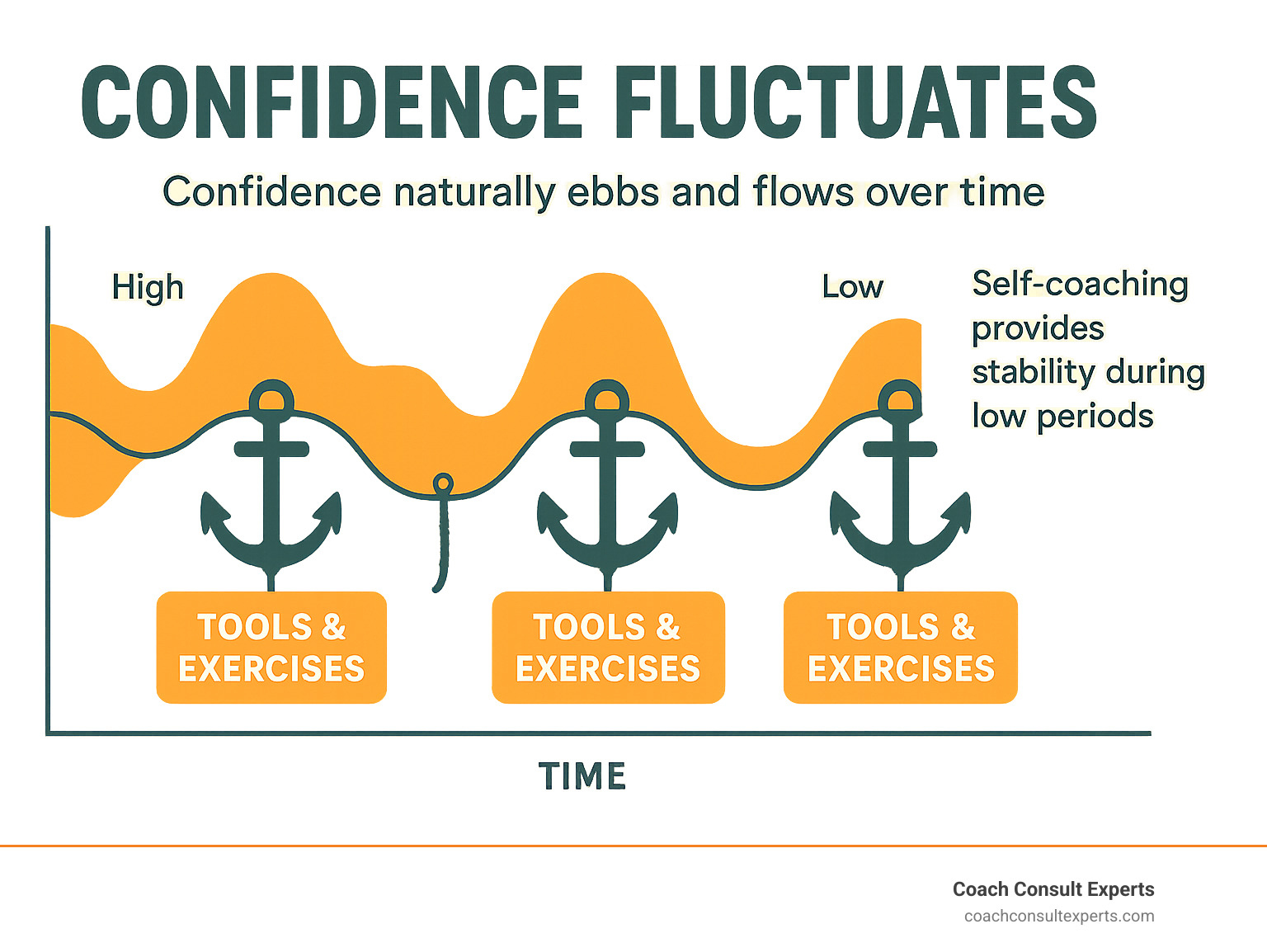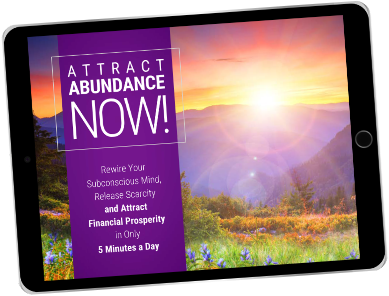Coach Yourself Confident: Top 5 Powerful Insights for 2025
Why Building Confidence Starts With Understanding Your Self-Doubt Tax
Coach yourself confident isn’t just another self-help phrase – it’s a proven approach to closing what Julie Smith calls the “confidence gap” between your capabilities and self-belief. If you’re feeling stuck despite your skills, you’re likely paying what Smith terms the “self-doubt tax” through either missed opportunities or exhausting overwork.
Quick Answer for “Coach Yourself Confident”:
- What it is: A self-coaching handbook by Julie Smith with practical exercises to build lasting confidence
- Key concept: The “self-doubt tax” – costs you pay through missed chances or burnout from overcompensating
- Main tools: Preparation calibration, inner critic management, confidence tracking graphs
- Best for: Professionals whose confidence lags behind their actual abilities
- Result: “Humble confidence” – balanced self-assurance without arrogance
The book won the 2024 getAbstract International Reader’s Choice Award for Business Impact, validating its practical approach. Smith’s three decades of coaching experience shows that confidence works like a muscle – it can shrink without exercise but grows stronger with the right training.
Research backs this up. A study cited in the book found college students relying on external validation experienced more stress and substance abuse, while those with internal confidence performed better academically. Your inner critic might be costing you more than you realize.
As Coach Mary Chege-Kamau, a PCC-credentialed coach with the International Coaching Federation, I’ve helped thousands of professionals transform their relationship with confidence over my decades of experience. Having seen clients struggle with the exact “confidence gap” that coach yourself confident addresses, I’ll break down whether this DIY approach can truly replace professional coaching support.

Handy coach yourself confident terms:
What Is the Premise of “Coach Yourself Confident”?
Julie Smith didn’t stumble into the confidence conversation by accident. After climbing the corporate ladder for 15 years at powerhouses like Mars and PepsiCo, she founded Talent Sprout in 2010 with a clear mission. Over three decades of leadership coaching, she kept seeing the same frustrating pattern: brilliant professionals whose self-doubt was holding them back from their true potential.
The heart of “Coach Yourself Confident” rests on a surprisingly simple idea – confidence works exactly like a muscle. Just as your biceps weaken without regular workouts, your confidence shrinks when you don’t exercise it. But here’s the game-changer: Smith reframes confidence as “trust in self” rather than vague self-esteem concepts, making it something you can actually practice and build.
This isn’t about puffing up your ego or pretending you’re perfect. Instead, Smith introduces the concept of “humble confidence” – that sweet spot where you trust your abilities while staying open to learning and growth. It’s confidence without the arrogance, strength without the rigidity.
The approach clearly resonates with readers and experts alike. Coach Yourself Confident won the 2024 getAbstract International Reader’s Choice Award for Business Impact and earned finalist status for the 2024/25 People’s Book Prize Non-Fiction. You can grab your copy on Amazon and dive into Smith’s practical framework.
Why Julie Smith Wrote It
Smith’s “aha moment” came from watching the same confidence struggles play out repeatedly in corporate boardrooms and leadership teams. She noticed that talented professionals were essentially paying what she calls the “self-doubt tax” in two devastating ways.
First, there were the missed opportunities – watching capable people shrink in meetings, avoid challenging projects, or pass up promotions they were absolutely qualified for. Then came the overwork exhaustion pattern, where high achievers would compensate for their inner doubts by over-preparing, over-delivering, and ultimately burning themselves out trying to prove their worth.
One client’s breakthrough became the book’s turning point. After months of coaching, this executive finally declared: “I don’t have anything to prove to anyone.” That shift from desperately proving themselves to simply performing their best became the foundation of Smith’s entire methodology.
Main Takeaways in One Sentence
Coach yourself confident teaches you to stop paying the self-doubt tax and open up humble confidence through practical, muscle-building exercises that help you trust your capabilities without losing your openness to growth and learning.
For those who want to combine Smith’s self-coaching tools with personalized support, our overcoming self-doubt programs at Coach Consult Experts provide the one-on-one guidance that can accelerate your confidence journey.
The Science & Cost of Self-Doubt
Here’s something that might surprise you: the “self-doubt tax” isn’t just Julie Smith’s clever way of describing confidence issues. It’s actually a measurable cost that shows up in your career, relationships, and overall well-being in very real ways.
Think of it like this – every time self-doubt creeps in, you’re essentially paying a fee. Sometimes you pay in missed opportunities when you don’t speak up in meetings or avoid applying for that promotion. Other times, you pay in exhaustion from overcompensating, like spending three hours preparing for a 30-minute presentation that really only needed one hour of prep.
The research backs this up beautifully. A study highlighted in Coach Yourself Confident followed college students and found something fascinating: students who constantly sought external validation (think approval from professors, parents, or peers) experienced significantly more stress and even higher rates of substance abuse. Meanwhile, students who built their confidence from internal values performed better academically and made healthier life choices.
What’s particularly interesting is how this connects to the physical side of confidence. Scientific research on exercise boosting confidence shows that regular physical activity doesn’t just improve your mood – it actually creates measurable hormonal changes that boost self-confidence. Your body and mind work together when building confidence.

Hidden Ways Self-Doubt Shows Up
Here’s where it gets tricky – self-doubt rarely walks up and introduces itself. Instead, it sneaks around wearing different disguises that can fool even the most self-aware people.
Over-preparation is probably the most common mask. You know that feeling when you spend hours crafting the perfect email or preparing for a meeting that could have been handled with much less effort? That’s your self-doubt tax in action. One executive Smith worked with realized she was spending entire weekends preparing for Monday morning presentations that her colleagues handled with just an hour of prep time.
Perfectionism is another sneaky one. It feels productive and professional, but it’s often just fear dressed up in a business suit. When nothing feels good enough, you’re not maintaining high standards – you’re avoiding the possibility of criticism or failure.
Imposter feelings show up when you attribute your successes to luck, timing, or anything except your actual capabilities. Even seasoned professionals find themselves thinking, “If they really knew what they were doing, they wouldn’t have chosen me for this role.”
The people-pleasing pattern emerges when you avoid difficult conversations or consistently say yes to requests that drain your energy. You’re essentially paying the self-doubt tax by sacrificing your own needs to maintain others’ approval.
Finally, analysis paralysis keeps you stuck in research and planning mode because making a decision feels too risky. You convince yourself you need just a little more information, but really you’re avoiding the possibility of being wrong.
Measuring Your Own “Tax Bill”
Getting honest about your self-doubt tax requires some detective work, but Smith provides practical tools to help you calculate what you’re really paying.
Start with a confidence scale assessment where you rate yourself from 1-10 in different areas – work presentations, difficult conversations, creative projects, or leadership situations. This gives you a baseline to work from.
Next, try an opportunity cost analysis. Write down specific chances you’ve avoided in the past six months because of self-doubt. Maybe you didn’t volunteer for a high-visibility project or skipped a networking event. These missed opportunities represent part of your tax bill.
The energy audit is particularly eye-opening. For one week, track how much time you spend on over-preparation or perfectionist behaviors. You might find you’re spending twice as long as necessary on routine tasks.
Finally, create an inner critic inventory by documenting the negative messages that play on repeat in your head. Common ones include “You’re not qualified enough,” “Everyone will see you don’t belong here,” or “You should have figured this out by now.”
We recommend keeping a simple confidence journal for one week, noting moments when self-doubt influenced your decisions. This creates a clear picture of your current patterns and gives you a foundation for measuring progress as you apply the coach yourself confident strategies.
How to Coach Yourself Confident: Frameworks & Exercises
The real magic of Coach Yourself Confident happens when you roll up your sleeves and dive into the practical exercises. Julie Smith has taken three decades of coaching wisdom and transformed it into tools you can use right now, without waiting for your next coaching session.
Think of these frameworks as your confidence toolkit. You wouldn’t expect to build physical strength with just one workout, and the same principle applies here. Smith’s preparation calibration, inner critic naming, and confidence tracking exercises work best when they become part of your regular routine.
The beauty of these tools is their flexibility. You can use them during your morning coffee, between meetings, or whenever self-doubt starts creeping in. For those who want to boost their progress, our mindset life coach services at Coach Consult Experts provide the perfect complement to these DIY approaches.
Preparation Calibration: Pay Less Self-Doubt Tax
This exercise tackles the sneaky way self-doubt drains your energy through over-preparation. Instead of spending hours on tasks that don’t really matter, you learn to right-size your prep and focus on what actually moves the needle.
Here’s how it works in real life. Start by writing a clear desired outcome sentence – just one or two lines about what you want from that upcoming presentation or meeting. This simple step alone cuts through mental fog and gives you a target to aim for.
Next, take an honest look at what you already bring to the table. List your existing knowledge, experience, and preparation. You might surprise yourself with how much you already have covered.
Now comes the eye-opening part. Write down every possible preparation task you could do – the essential ones and the “nice to have” ones. Then ruthlessly cross off anything that doesn’t directly support your desired outcome.
One reader shared how this transformed their client meetings. Instead of creating elaborate presentation materials that nobody really needed, they focused on three key talking points. The result? They felt more confident, not less, because their preparation was intentional and targeted.
This builds what Smith calls humble confidence – that sweet spot where you trust your abilities while staying open to growth and feedback.
Taming the Inner Critic with “Coach Yourself Confident” Tools
Your inner critic has been practicing its negative messages for years, so it’s gotten pretty good at its job. The good news? You can retrain it, but it takes the same kind of consistent practice.
Smith’s approach starts with a simple truth: those critical thoughts aren’t facts about you – they’re just mental habits that have gotten out of hand. The first step is catching your inner critic in action and recognizing it as a separate voice, not your true self.
Here’s where things get interesting. Smith suggests naming your inner critic and even drawing or visualizing it as a distinct character. Her workshop participants have chosen names like “Nigel the Nitpicker” or “Worried Wendy.” This might sound silly, but it creates psychological distance that weakens the critic’s grip on you.
Once you’ve named your critic, you can start talking back with supportive affirmations that directly counter its favorite lies. If your critic loves to whisper “You’re not qualified for this,” your response might be “I have valuable experience and I’m learning as I go.”
The key is consistency. Your inner critic got strong through repetition, and your supportive voice will grow the same way. For additional insights on managing your inner critic, you might find value in coaching the inner critic resources from professional coaching organizations.
Tracking Your Confidence Curve & Responding to Dips
One of the most liberating insights from Coach Yourself Confident is that confidence naturally ebbs and flows – it’s not supposed to stay high all the time. Understanding this pattern helps you stop panicking when confidence dips and start responding strategically instead.
Smith’s ebb-and-flow graph exercise helps you map your confidence over time. Draw a simple line graph showing your confidence highs and lows over the past year. You’ll start noticing patterns – maybe your confidence drops during busy seasons, or peaks after completing challenging projects.
The real power comes from reusing past wins. When you’re in a confidence valley, you can look back at previous peaks and remember: “I’ve handled tough situations before, and I can do it again.” One client realized that the resilience she showed during a difficult divorce was exactly what she needed to tackle a career transition.
Smith also recommends creating a micro-actions list – small, specific steps you can take when confidence wavers. These might include reviewing past accomplishments, calling a supportive friend, or using the mantra “good enough and better” to counter perfectionist tendencies.
The Five Senses grounding technique rounds out your confidence toolkit. When self-doubt spirals, anchor yourself by noticing five things you can see, four you can touch, three you can hear, two you can smell, and one you can taste. This simple exercise pulls you out of mental loops and back into the present moment where you can take action.
Building Humble Confidence for Sustainable Growth
The magic of coach yourself confident lies in what Julie Smith calls “humble confidence” – a balanced approach that sets this book apart from typical confidence-building advice. This isn’t about puffing yourself up or becoming that person who dominates every conversation. Instead, it’s about finding that sweet spot between self-doubt and arrogance.
Smith captures this beautifully with her core mantra: “I am good enough, and I can be better.” This simple phrase acknowledges your current capabilities while keeping you open to growth and learning. It’s like having a friendly conversation with yourself instead of either harsh criticism or empty praise.
Research backs up why this balanced approach works so well. Studies show that overconfidence can actually hurt you just as much as underconfidence – leading to poor decisions and damaged relationships. The humble confidence approach gives you that perfect middle ground where you trust yourself without losing your curiosity.
Amy Cuddy’s fascinating research on power poses, detailed in her book Presence, shows how your physical posture can actually trigger confidence-boosting hormone changes in your body. This body-mind connection supports Smith’s holistic view that confidence isn’t just mental – it’s a whole-person experience.

For professionals who want to develop this balanced confidence in leadership roles, our coaching for self-esteem programs provide additional tools and personalized support that complement the book’s DIY approach.
Why Confidence Must Come From Within
One of the strongest messages in coach yourself confident is why you can’t build lasting confidence by waiting for other people’s approval. Smith’s research reveals that when you rely on external validation, you’re building your confidence on shaky ground that crumbles the moment someone criticizes you.
Building genuine internal confidence involves clarifying your values so you know what truly matters to you, not what others think should matter. It means reframing feedback as useful data rather than verdicts on your worth as a person. You learn to practice self-compassion by treating yourself with the same kindness you’d show a good friend who made a mistake.
Perhaps most importantly, you start acknowledging your achievements instead of brushing them off or attributing them to luck. The college student study Smith references drives this point home – students with internally-based self-worth showed greater resilience, better grades, and healthier ways of handling stress compared to those constantly seeking approval from others.
Think of it this way: external validation is like renting your confidence from other people, while internal confidence is like owning your own home. One leaves you vulnerable to eviction, while the other gives you security and control.
Team & Leadership Implications
Here’s something fascinating about the coach yourself confident approach – it doesn’t just change you, it ripples out to everyone around you. Leaders who embody humble confidence create what psychologists call “psychological safety,” where team members feel safe to take appropriate risks and learn from failures.
Smith’s corporate experience revealed a troubling pattern: self-doubting leaders create cultures where everyone second-guesses themselves. Team members start over-preparing for meetings, avoiding innovative thinking, and playing it safe to avoid any possibility of criticism. It’s like emotional contagion, but in reverse.
When leaders model humble confidence, they make decisions with appropriate speed rather than getting stuck in analysis paralysis. They admit mistakes without getting defensive because their self-worth isn’t tied to being perfect. They encourage dissenting views because they’re secure enough to handle disagreement.
Most importantly, these leaders focus on solutions rather than blame and consistently model that “good enough and better” mindset. They show their teams that you can trust your current abilities while staying open to improvement – a powerful combination that drives both individual growth and team performance.
The change often surprises people. One executive Smith worked with finded that when she stopped over-preparing for every meeting, her team actually respected her more, not less. Her confidence gave them permission to trust their own judgment too.
Frequently Asked Questions about “Coach Yourself Confident”
Can “Coach Yourself Confident” replace live coaching?
Here’s the honest truth: coach yourself confident provides excellent DIY tools that many readers find transformative, but it can’t fully replace the personalized attention of working with a professional coach.
Smith designed these exercises to feel like having a coach by your side, and she succeeds remarkably well. The book’s strength lies in its practical frameworks that you can apply immediately without waiting for your next coaching session. Many professionals find the preparation calibration and inner critic exercises particularly powerful for day-to-day confidence building.
However, live coaching brings unique advantages that no book can replicate. A skilled coach spots blind spots you might miss when working alone. They provide real-time accountability and can dive deeper into complex issues that surface during your confidence journey.
The sweet spot? Combining both approaches. At Coach Consult Experts, we’ve noticed that clients who practice the book’s exercises between our sessions make significantly faster progress. The self-coaching tools maintain momentum while professional support provides personalized insights and deeper exploration when you hit roadblocks.
Think of the book as your daily confidence workout, with professional coaching as your personal trainer for the more challenging lifts.
How long until I feel more confident?
Smith’s muscle analogy applies perfectly here – you wouldn’t expect to bench press your body weight after one gym session, and confidence building follows similar patterns.
Most readers report initial shifts within 2-4 weeks of consistent practice. These early changes often feel subtle: you might notice yourself speaking up more in meetings or spending less time over-preparing for presentations. The more substantial changes typically emerge over 2-3 months of regular application.
The secret ingredient is frequency over intensity. Daily 10-minute confidence exercises often produce better results than marathon weekend sessions. Just like physical fitness, showing up consistently matters more than perfect execution.
You’re rewiring decades of self-doubt patterns. Be patient with the process while celebrating small wins along the way.
What if my confidence keeps fluctuating?
Take a deep breath – this is completely normal! Smith emphasizes throughout coach yourself confident that confidence naturally ebbs and flows like ocean tides. Expecting constant high confidence is like expecting perfect weather every day.
The goal isn’t becoming a confidence robot. Instead, you’re developing awareness of your natural patterns, tools to respond constructively during low periods, perspective that dips are temporary, and skills to rebuild when confidence wavers.
Life throws curveballs – job changes, relationship challenges, health issues – that naturally impact your confidence levels. The book’s exercises become more valuable over time as you learn to adjust them for different seasons of life.
Think of confidence fluctuations as valuable data rather than personal failures. Each dip teaches you something about your triggers and resilience patterns.

Conclusion & Next Steps
Coach yourself confident isn’t just another self-help book gathering dust on your shelf – it’s a practical toolkit that actually works. Julie Smith’s three decades of coaching experience shine through every exercise, creating tools that feel real rather than theoretical.
The beauty of Smith’s approach lies in that humble confidence sweet spot. Her mantra “I am good enough, and I can be better” gives you permission to trust your abilities while staying curious about growth. No ego inflation required.
That preparation calibration exercise alone could revolutionize how you approach meetings and presentations. Instead of drowning in unnecessary prep work, you’ll focus on what truly matters. One reader told us it saved them five hours a week while actually boosting their confidence in client meetings.
The honest truth? Self-coaching has its limits. Smith’s exercises are brilliant, but sometimes you need another human to spot your blind spots or hold you accountable when motivation wanes. Think of the book as your foundation, not necessarily your entire confidence-building journey.
At Coach Consult Experts, we’ve watched clients combine Smith’s techniques with our rapid subconscious change methods. The results speak for themselves – coach yourself confident exercises between sessions accelerate progress in ways that surprise even us.
Your confidence is like a muscle that’s been sitting dormant, waiting for the right workout routine. Whether you start with Smith’s DIY approach, jump into professional coaching, or blend both paths, the important thing is starting somewhere.
Ready to ditch that self-doubt tax once and for all? Begin with the book’s exercises and see how they feel. If you find yourself wanting deeper support or faster change, our VIP coaching programs are designed to amplify exactly what Smith teaches.
Remember – every confident person you admire started exactly where you are now. The only difference? They decided to do something about it.



